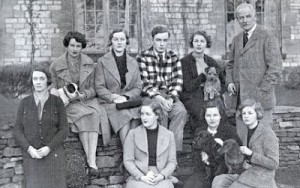The recent death of the Dowager Duchess of Devonshire got me to thinking about the genealogical treatment of titles. Titles can be tricky, and many American genealogists – confronted with medieval British or European titles in their ancestry – prefer to ignore them or, conversely, string them all together and hope that the result is acceptable.
The same is true of the American press. At present, The New York Times behaves as though someone with a title doesn’t use it. In the Duchess’s obituary, the headline called her Deborah Cavendish – true enough, but Cavendish is hardly the name (or the rank) by which she was best known. (I should add that in the body of the obituary, she is correctly identified as the Dowager Duchess, as well as one of the “eccentric Mitford sisters.”)
Using the Duchess as an example, let’s look at the various names and titles by which she was known. There were several:
- As the youngest daughter of the 2nd Baron Redesdale, she was the Honourable (Hon.) Deborah Freeman-Mitford from birth. In social usage, her parents were Lord and Lady Redesdale. The courtesy title of Hon., accorded the younger sons of earls and the sons and daughters of viscounts and barons (and those sons’ spouses), does not entitle the bearer to any higher rank than Mr., Mrs., or Miss.
- In 1940, she married Lord Andrew Cavendish, younger son of the Duke and Duchess of Devonshire. By doing so, she became Lady Andrew Cavendish, and this is really the only period in which she was Deborah Cavendish. The younger sons of dukes and marquesses bear the courtesy title of Lord; their wives are called Lady, but Lady Andrew is correct where Lady Deborah would not be, as she was taking her rank from her husband.
- In 1944, Lord Andrew’s older brother, the Marquess of Hartington, was killed in action, and Andrew succeeded him as their father’s heir. Andrew and Deborah became the Marquess and Marchioness of Hartington. Their son, the present Duke of Devonshire, was known by his own courtesy title (Earl of Burlington); their daughter now became Lady Emma Cavendish. Even though Lord and Lady Hartington held courtesy titles (Hartington and Burlington being subsidiary titles belonging to Andrew’s father, the Duke of Devonshire), they were treated in almost every way as peers in their own right; certainly this was the case socially, and in the way they were addressed.
- Finally, in 1950, Andrew succeeded his father, and the Hartingtons became His Grace The Duke and Her Grace The Duchess of Devonshire. Lord Burlington became Lord Hartington, but Lady Emma – now the daughter of a duke – remained Lady Emma, with a higher rank but no title change, all daughters of dukes and marquesses being addressed as Lady. Emma’s husband would garner no title change by marrying her, husbands giving their wives rank but not (usually) the other way around.
- At Andrew Devonshire’s death, Deborah became the Dowager Duchess. Sometimes, when peers divorce, their wives take the style (for example) of Deborah, Duchess of Devonshire, so that is also a correct way to address a peeress.
The British usage is complicated, but titles – with all the history they represent – can be fascinating and, all evidence to the contrary, they can fairly easily be understood.
Share this:
About Scott C. Steward
Scott C. Steward has been NEHGS’ Editor-in-Chief since 2013. He is the author, co-author, or editor of genealogies of the Ayer, Le Roy, Lowell, Saltonstall, Thorndike, and Winthrop families. His articles have appeared in The New England Historical and Genealogical Register, NEXUS, New England Ancestors, American Ancestors, and The Pennsylvania Genealogical Magazine, and he has written book reviews for the Register, The New York Genealogical and Biographical Record, and the National Genealogical Society Quarterly.View all posts by Scott C. Steward →
